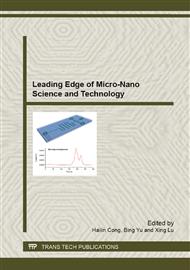p.185
p.189
p.194
p.204
p.208
p.217
p.221
p.226
p.233
Interaction between Cationic Nano Microsphere and HPAM
Abstract:
This paper intends to deal with one novel profile control agent formed by combination of HPAM and cationic microspheres with different cationic density (CD) by the method of micro-emulsion polymerization. Profile control is of great importance in well stimulation for current oilfield with high water cut. The main profile control agents now are polymer or polymer microspheres. Each of these agents has its own performance advantages. The novel profile control agent is equipped with the advantages of both the agents mentioned above. Analyzed by transmission scan electron microscope (TSEM) and laser particle sizer, the particle size of the original synthesized microsphere and the swelled microsphere in water are 50-100nm and 1-3μm respectively. Analyzed by micro-electrophoresis, the surface potential arrives at its highest value at 30% of the cationic density; aggregation happens when CD is low and the electrostatic force is insufficient to keep the system stable. Due to electrostatic interaction, the synthesized system flocculates at a concentration of 0.02% separately. Measured at varied shear rates, the viscosity of the system can be significantly enhanced by electrostatic interaction. However, this enhancement is not obvious when the salinity is higher than 3%, which indicates that the increasing of viscosity is closely related to the salinity of solution. Moreover, by increasing hydrolysis degree of HPAM, the viscosity of the system can be improved by 20% additionally. Through core displacement test, the synthesized system is proved to have relatively good profile control performance.
Info:
Periodical:
Pages:
208-216
Citation:
Online since:
March 2013
Authors:
Price:
Сopyright:
© 2013 Trans Tech Publications Ltd. All Rights Reserved
Share:
Citation:


